
S.Warren. Designing organic syntheses
..pdf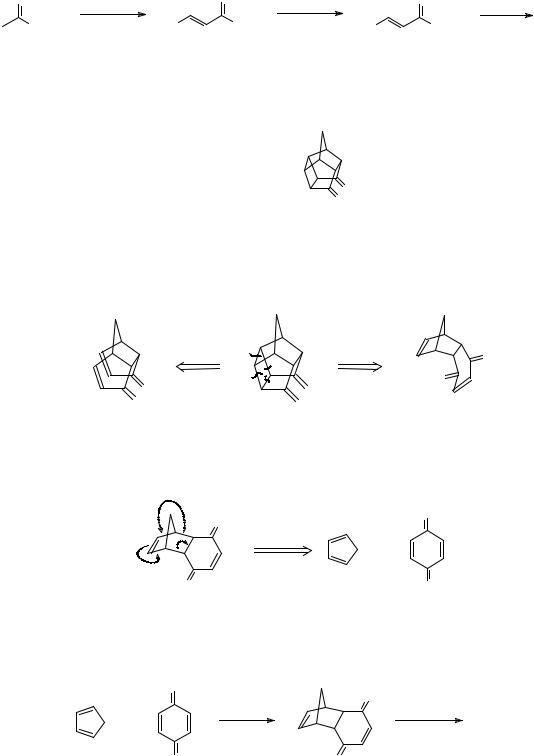
97
The keto-acid is the readily available pyruvic acid; there are many possible syntheses of this.
Synthesis: The reactions were actually carried out like this: (Stereoand regioselectivity turn out all right, J. Amer. Chem. Soc., 1924, 46, 783).
O |
PhCHO |
|
O |
MeOH |
|
O |
light |
|
|
|
|||||
|
NaOH |
Ph |
CO2H |
H+ |
|
|
TM 297 |
CO2H |
Ph |
CO2Me |
75% |
||||
|
|
|
80% |
|
|
|
|
_______________________________________
299. Review problem 30: This may look rather difficult, but concentrate on the small ring and use the disconnection you know. Suggest a synthesis for TM 299.
TM 299 |
O |
|
O |
_______________________________________
300. Analysis: This cage-like structure contains 6, 5 and 4-membered rings: we are most interested in the 4, and can disconnect this in two ways:
b |
b |
a |
O |
 a
a
O O
B
a b |
O |
O |
|
O |
A |
No doubt we could continue with B by disconnecting the α,β-unsaturated carbonyl groups, but intermediate A should be recognisable as a Diels-Alder product, and this is the shorter route:
O
O
D - A
+
O O
both these starting materials are readily available.
Synthesis: Amazingly, this complicated molecule is made in just two steps!
O
|
O |
+ |
light |
TM 299 |
|
O |
O |
_______________________________________
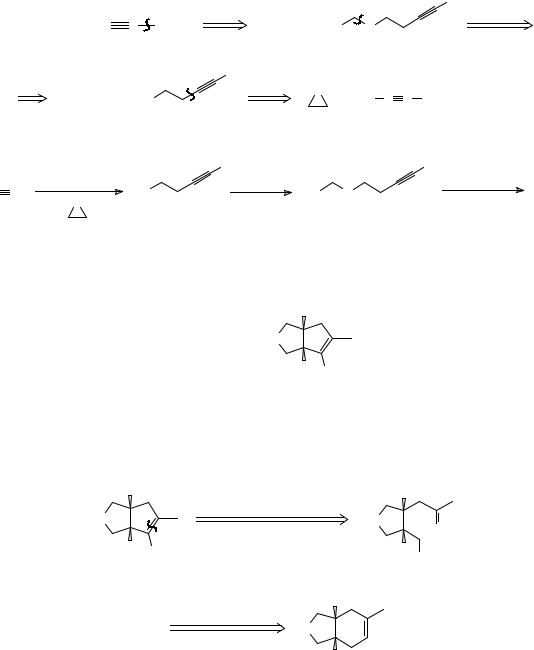
98
I. GENERAL REVIEW PROBLEMS
301. These problems may involve any disconnections from any section and by useful to you for revision material.
Review problem 31: Design a synthesis for TM 301.
TM 301 |
PhCH2O . CH2CH2C |
|
C . CH2OH |
|
|||
|
|||
|
_______________________________________
302. Analysis: A simple problem to get you started – disconnect the unprotected side of the acetylene first.
|
|
|
|
H |
PhCH2O . CH2CH2C |
C CH2OH |
CH2O + Ph |
|
ether |
|
O |
|||
|
|
H |
|
|
PhCH2Br |
+ HO |
O |
+ |
H C C H |
|
Synthesis: (As described in J. Amer. Chem. Soc., 1966, 88, 3859).
|
H |
|
|
H |
|
|
Na , liq NH3 |
base |
|
|
Na , liq NH3 |
TM 301 |
|
HC CH |
HO |
Ph |
O |
CH2O |
||
|
||||||
O |
PhCH2Br |
|
|
|
_______________________________________
303. Review problem 32: Design a synthesis for TM 303, an intermediate used in the synthesis of substances found in ants.
|
H |
|
|
O |
|
TM 303 |
H |
CHO |
|
|
_______________________________________
304. Analysis: We must first decide whether to disconnect the ether ring or the α,β-unsaturated aldehyde. No doubt reasonable routes could be produced for both, but I shall give one only:
H |
H |
α,β −unsaturated |
|
O |
O |
carbonyl |
O |
H CHO |
H |
|
CHO |
This is a 1,6-dicarbonyl compound so we must ‘re-connect’ into a cyclohexene.
H
1,6 - di CO
O
H
This has the oxygenation pattern of a Diels-Alder adduct if we convert it to a carbonyl compound.
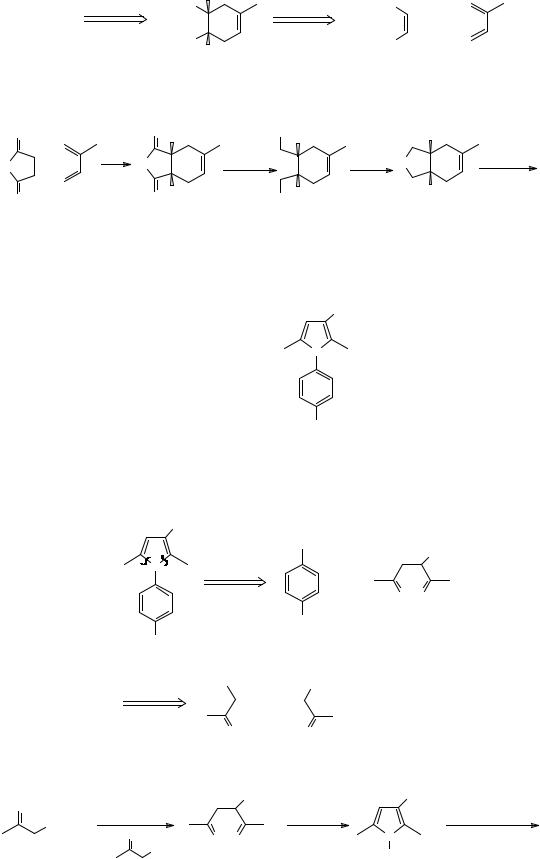
99
FGI |
EtO2C |
H |
D - A |
EtO2C |
|
|
|
|
+ |
|
EtO2C |
H |
|
EtO2C |
|
|
|
|
Synthesis: A successful synthesis (J. Amer. Chem. Soc., 1958, 90, 3937) by this route actually uses maleic anhydride:
|
O |
O |
H |
|
OH H |
H |
|
O |
+ |
O |
|
LiAlH4 |
TsCl O |
1. OsO4 |
TM 303 |
|
|
|
|
|
NaOH |
2. NaIO4 |
|
|
O |
O |
H |
|
OH H |
H |
|
|
|
cyclisation occurred |
|||||
spontaneously
_______________________________________
305. Review problem 33: Design a synthesis for TM 305, introduced in 1974 as the antiinflammatory drug ‘clopinac’.
CO2H
N
TM 305
Cl
_______________________________________
306. Analysis: The most sensible place to start is with the N-C=C bonds as that will give us some carbonyl groups (as in frames 253-7)
CO2H
|
NH2 |
CO2H |
N |
|
|
+ |
|
|
|
O O |
|
|
|
|
|
Cl |
|
Cl |
readily available |
|
1,4-dicarbonyl, guided by the presence of the extra CO2H group.
Cl |
CO2Et |
protection needed |
|
+ |
|
O |
O |
|
Synthesis: It’s difficult to find out how drug companies make their products (understandably!) so we can only speculate:
O |
1. EtO |
- |
CO2Et |
|
CO2Et |
|
ArNH2 |
|
|||
CO2Et |
|
|
TM 305 |
||
O |
|
|
N |
||
2. |
|
O O |
hydrolysis |
||
|
|
Cl Ar
_______________________________________
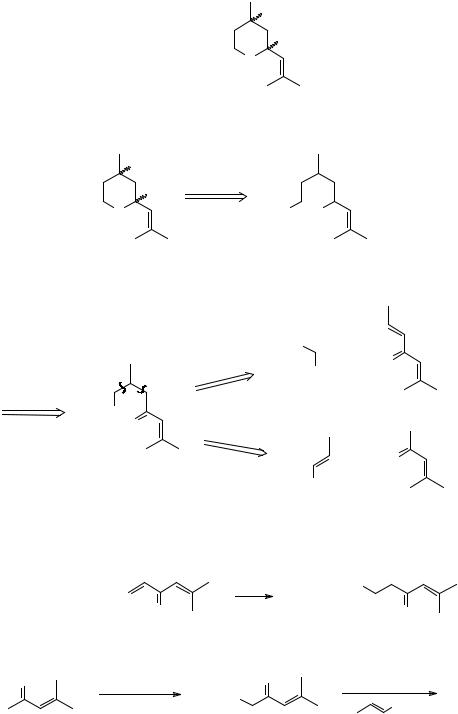
100
307. Review problem 34: Design a synthesis for rose oxide, TM 307, a perfume occuring in rose and geranium oils which is made at present by the oxidation of another natural product, citronellol.
H
H
O
TM 307
_______________________________________
308. Analysis: The cyclic ether can clearly be made from the open-chain diol:
H
FGI
H
O |
HO HO |
We now have a 1,5-di O relationship which could be made by a Michael reaction if we have two carbonyl groups.
|
|
EtO2C |
a |
a |
EtO2C |
b |
|
|
FGI |
|
|
EtO2C |
O |
b |
|
||
|
|
|
|
|
EtO2C |
+
+
O
A
O
B
Synthesis: You will see that there are problems in both the routes found by the analysis. For route a it is known that malonate attacks exclusively the less hindered side of some Michael acceptors:
(EtO2C)2CH2 + |
(EtO2C)2CH2 |
|
|
O |
O |
but whether it would be so selective for A with an extra methyl group is doubtful. For route b, the problem is to activate the methyl group of B and one method which might work is:
|
|
O |
? |
O |
base |
base |
|
|
|
EtO2C |
B |
|
(EtO)2CO |
CO 2Et |
|
|
|
||
|
|
|
The last stages are simple enough.
The modern organic chemist has a variety both of reagents and reactions far beyond those we have looked at here. If you study organic chemistry to a more advanced level you should meet many of them but you will find that the principles of their design and use are the same as those you have learnt in this programme. We have now finished the basic types of disconnection and must look at the strategy of synthesis.
_______________________________________
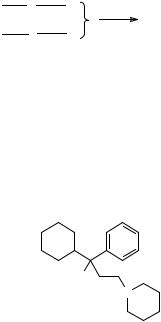
101
J. STRATEGY
1. CONVERGENT SYNTHESES
309. We have so far dealt mainly with the tactics of synthesis: “what is a good disconnection?” and only occasionally with strategy: “by what series of disconnection, even those which do not initially look very good, can I get back to good starting materials?” Now we must consider strategy – the overall plan of the synthesis. Our first criterion of a good synthesis is that it must be short. Work out for yourself the yield in each of these two syntheses: the yield in every step being 90%.
1. A  B
B  C
C  TM
TM
2.A  B
B  C
C  D
D  E
E  TM
TM
_______________________________________
310. Yield for the 3-step synthesis (1.) is 73% Yield for the 5-step synthesis (2.) is 59%
By the time you get to a ten step synthesis, the “arithmetic demon” ensures that the yield is down to a miserly 35%. And this with 90% yield in each step! So clearly a short synthesis is a good one. But we can cheat the arithmetic demon by making our five steps convergent rather than linear. The convergent version is this:
A B C
TM
D E F
If the yield of each step is again 90%, what is the overall yield of this five step convergent synthesis?
_______________________________________
311. Clearly it is the same as the three step synthesis, 73%. So it is better to assemble two more or less equal parts of a molecule separately and join them together at the end. Let’s look at this in practice. What three alternative disconnections are immediately obvious on TM 311?
HO
N
TM 311
_______________________________________
312. Analysis: Clearly we can remove any of the three groups from the tertiary alcohol.
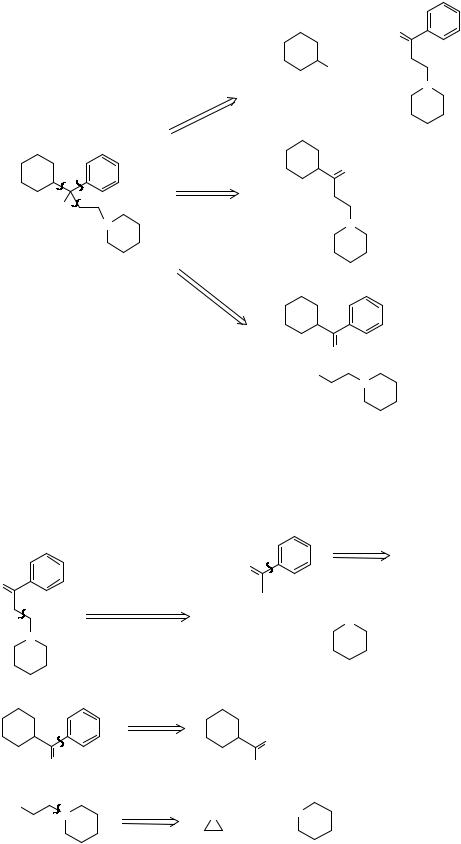
102
O
+
MgX
N
a
a b |
b |
O |
|
+ PhMgX |
|||
|
|||
c |
|
||
|
|
||
HO |
|
|
|
N |
|
N |
|
|
|
c |
O
XMg
N
Seeing the aromatic ketones in a and c we might have a Friedel-Crafts reaction in mind. Continue these two a stage further.
_______________________________________
313.
a) |
F - C |
+ MeCOCl |
PhH |
||
|
O |
|
O |
|
|
Mannich |
H |
|
+ |
|
|
N |
|
|
N |
CH2O + |
|
c) |
F - C |
|
|
|
+ PhH |
|
|
|
|
O |
|
|
|
|
|
|
|
O |
|
|
Cl |
|
|
X |
C - N |
O |
|
|
HN |
N |
|
+ |
|
||
|
|
|
|
|
Perhaps you can see that one of these routes is linear and the other convergent. Write both out in full as syntheses to make this clear.
_______________________________________
314.
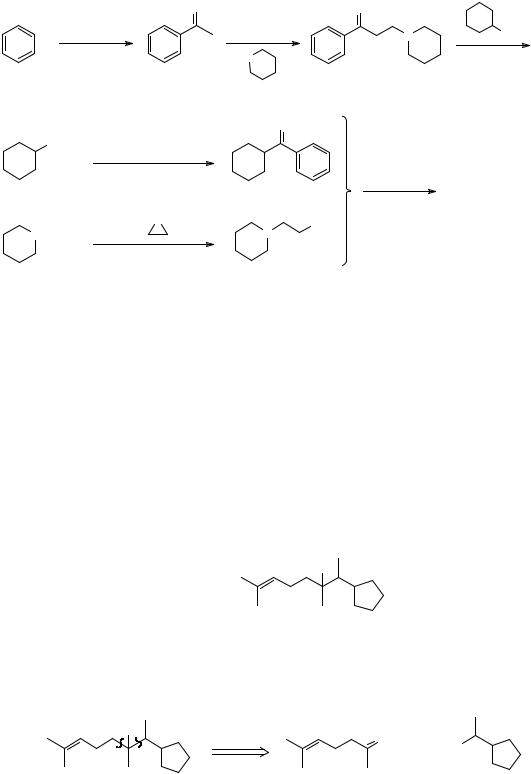
103
a) |
|
|
O |
O |
|
|
MeCOCl |
|
CH2O |
N |
MgX |
|
AlCl3 |
|
|
|
TM 311 |
|
|
HN |
|
|
|
|
|
|
|
|
Linear |
c) |
|
|
|
O |
|
|
CO2H |
1. SOCl2 |
|
|
|
|
|
|
|
||
|
|
2. PhH , |
AlCl3 |
Mg |
|
|
|
|
|
TM 311 |
|
|
|
|
|
Et2O |
|
|
|
|
O |
|
|
|
|
1. |
Cl |
|
|
NH |
|
N |
|
||
|
|
|
|||
|
|
|
|
||
2. PCl5
Convergent
TM 311 is in fact the anti-Parkinson’s disease compound trihexylphenidyl and is made industrially by route c (Tedder, volume 5, p.418).
_______________________________________
315.You may like to reflect on our criteria for good disconnections (see for example frame 76). Two of them could be called simply guides to help us find convergent syntheses. Which ones?
_______________________________________
316.1. the greatest possible simplification.
2. the use of a branch point.
With this in mind, suggest a convergent synthesis for TM 316.
HO
TM 316
______________________________________
317. Analysis: Obviously we have to disconnect one of the groups next to the tertiary alcohol: two (a or b) give us plenty of simplification but only one (a) leads us back to a branch point:
HO |
|
O |
|
|
a |
|
+ |
Br |
|
b a |
|
|
||
|
|
|
||
|
A |
|
|
B |
|
|
|
|
If you haven’t yet considered it: how would you make A and B?
_______________________________________
318. One of our stsndard disconnections on a ketone (frame 56) gives us a synthesis of A from TM 31.
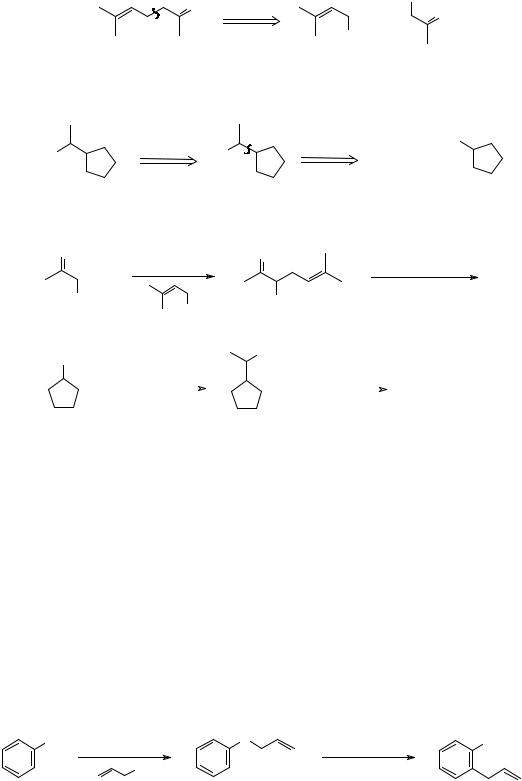
104
O |
|
CO2Et |
|
+ |
O |
||
|
|||
|
|
||
A |
Br |
|
|
TM 31 |
|
||
|
|
B can be made by the usual methods:
Br |
FGI |
HO |
|
Br |
|
MeCHO |
+ |
||||
|
|||||
|
|
|
Synthesis:
O |
O |
|
1. HO- , H2O |
|||
|
EtO- |
|
|
|
||
|
|
|
|
|
2. H+ |
A |
CO2Et |
CO2Et |
|
, heat |
|||
|
Br |
|
|
|
|
|
Br |
OH |
|
|
|
||
|
|
|
|
|
||
|
1. Mg , Et2O |
|
|
1. PBr3 |
TM 316 |
|
|
2. MeCHO |
|
|
2. Mg , Et2O |
||
|
|
|
|
|
||
|
|
|
|
3. A |
|
|
There are undoubtedly many other good approaches; as far as I am aware, this molecule has not been made by this route.
_______________________________________
2. STRATEGIC DEVICES
(a) C - HETEROATOM BONDS
319. You have already seen that a carbon-heteroatom bond is easy to make, since we used such bonds as natural places for disconnections (frames 234 ff). It is good strategy therefore to make a carbon-heteroatom bond and then to transform it into a carbon-carbon bond. The Claisen rearrangement is one way to do this: an ortho allyl phenol (B) made from an allyl ether (A):
OH |
base |
O |
heat |
OH |
|
|
|
||
|
|
Br |
|
B |
|
|
A |
|
|
|
|
|
|
Draw a mechanism for the second step (A to B).
_______________________________________
320. The reaction begins with a pericyclic step:
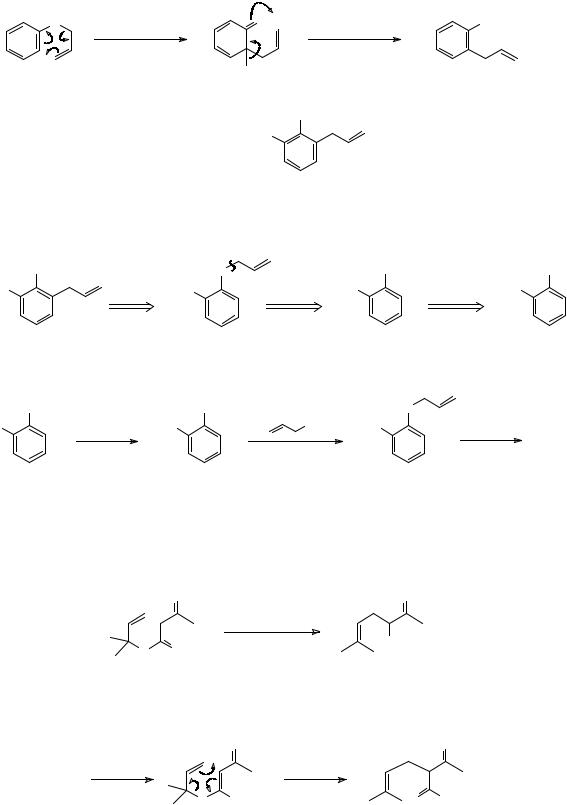
105
|
O |
H+ |
O |
OH |
|
A |
H |
B |
|
How then would you make eugenol (TM 320), a constituent of oil of cloves?
OH
MeO
TM 320
_______________________________________
321. Analysis: The ortho arrangement of OH and allyl is the clue:
OH |
|
O |
|
OH |
|
OH |
MeO |
MeO |
C - O |
MeO |
|
C - O |
HO |
|
|
|
|
|
Synthesis: From readily available catechol (A):
OH |
|
|
OH |
HO |
base |
MeO |
Br |
|
O
MeO |
heat |
TM 320
MeI |
base |
A
_______________________________________
322. In an important industrial process, the “Carroll reaction”, an aliphatic version of the Claisen rearrangement occurs. See if you can find the right mechanism:
O |
O |
|
|
heat |
|
O O |
CO2H |
|
B |
||
A |
_______________________________________
323. The trick is to make the enol – the stable enol of the β-keto ester:
O |
O |
O OH |
O OH |
The ester 322A is made by ester exchange with ethyl acetoacetate and a suitable alcohol. The product 322B decarboxylates spontaneously on heating. Draw out the whole sequence starting from ethyl acetoacetate.
_______________________________________
324.
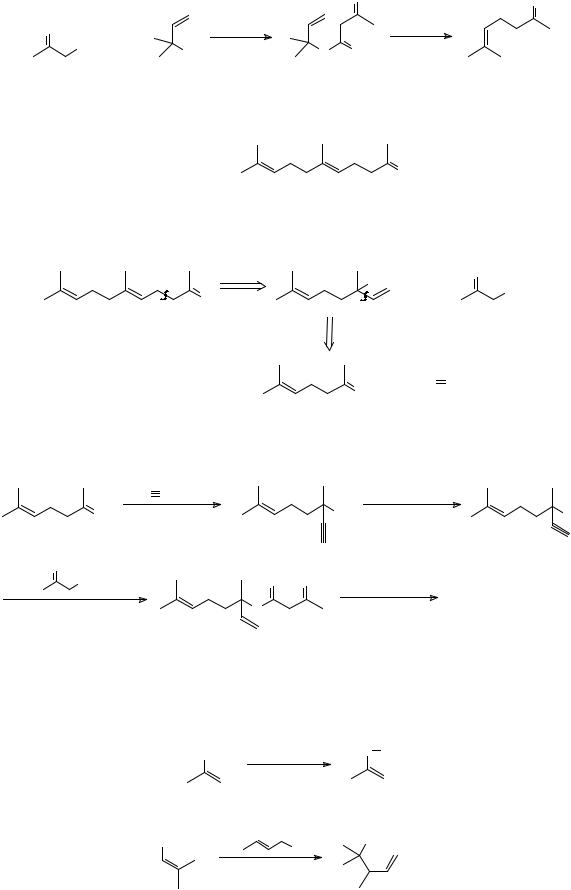
106
|
|
O |
O |
|
|
|
|
||
O |
+ |
|
heat |
|
CO2Et |
O O |
A |
||
OH |
We made this important intermediate (A) in a slightly different way (frame 318), but this is how it’s made industrially for use in perfumes and flavours (Pure. Appl. Chem., 1975, 43, 527). How would you extend this synthesis to make TM 324?
TM 324 |
O |
|
_______________________________________
325. Analysis: Reversing the Carroll reaction:
OH |
+ |
O |
|
CO2Et |
|||
O |
|||
|
|
+ |
-CH CH2 |
O |
|
The vinyl anion synthon is best represented by an acetylide ion (frame 33). Synthesis:
HC |
CH , Na |
|
H2 - Pd - C |
|
O |
lig NH3 |
OH |
BaSO4 |
OH |
O
CO 2Et
O O |
heat |
|
TM 324
ester exchange |
O |
_______________________________________
326. Another similar example concerns the alkylation of enamines. This reaction works well with reactive α-halocarbonyl compounds (frames 175ff) but simple alkyl halides often react on nitrogen:
|
|
+ |
R2N |
R ' Hal |
R2N R' |
Allyl halides do however give us good yields of alkylation at carbon:
Me2N |
1. |
CHO |
|
|
Br |
|
2. H2O |
67% |
|
|
A |
Suggest how this might happen.
_______________________________________
